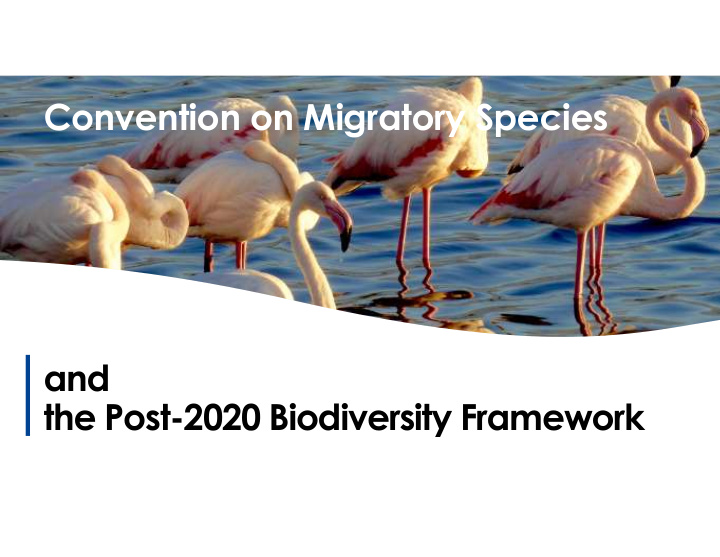



Convention on Migratory Species and the Post-2020 Biodiversity Framework
Convention on Migratory Species Connectivity and the Post-2020 Biodiversity Framework Strategic Plan for Migratory Species 2015-2023 - Process • CMS COP10 Res 10.5 in 2011 launched the development of a new Strategic Plan led by a Working Group which took into account, among others, the Strategic Plan for Biodiversity; • CMS COP11 Res 11.2 in 2014 adopted the SPMS; • CMS COP12 Res 11.2 (Rev.COP12) in 2017 adopted indicators and endorsed guidance on implementation support. • CMS COP13 (February 2020, Gandhinagar, India) will provide an opportunity for Parties to examine progress in implementing the SPMS and to develop further inputs to the global biodiversity framework.
Convention on Migratory Species Connectivity and the Post-2020 Biodiversity Framework Strategic Plan for Migratory Species 2015-2023 - Approach The SPMS complements the Strategic Plan for Biodiversity, adding the necessary specificity for and focus on migratory species. The SPMS: … calls for a migratory systems approach to conservation strategies that give holistic attention to populations, species and habitats as well as the entire span of migration routes and the functioning of the migration process; … emphasizes that the multi-dimensional connectedness of migratory species gives them a special role as ecological keystone species and indicators of the linkages between ecosystems and of ecological change.
Convention on Migratory Species Connectivity and the Post-2020 Biodiversity Framework CMS and the post-2020 biodiversity framework • In 2018, a Working Group (WG) on the development of contributions to the post-2020 global biodiversity framework was established in the context of the CMS Family; • The WG comprises members of the Scientific Council and the Standing Committee, as well as NGOs and the Secretariats of CMS and its Family of Agreements ; • The WG determined that the conservation needs of migratory species can be best represented in the future global biodiversity framework through the concept of connectivity.
Convention on Migratory Species Connectivity and the Post-2020 Biodiversity Framework The importance of Connectivity • What is Connectivity? • Connectivity has been defined in a number of ways, addressing not only migratory connectivity but also habitat connectivity, genetic connectivity and other aspects; • Connectivity is essential for healthy ecosystems and resilience; • For migratory species conservation, considering connectivity as a property of geographical areas allows the identification of areas through which individuals move, and actions to lessen the threats that may hamper survival in each of these areas; • Connectivity goes beyond linking protected areas and other conservation-based areas.
Convention on Migratory Species Connectivity and the Post-2020 Biodiversity Framework Operationalizing Connectivity • CMS has taken steps to enhance understanding and delivery in this area in mainly in the context of work on “ecological networks” through various Resolutions; • Connectivity is key for the identification and planning of the spatial structure of networks of protected areas and other sites managed for conservation purposes as well as for actions with respect to areas outside of protected areas and OECM; • Connectivity provides a means by which multiple countries can agree on shared goals beyond national plans and priorities, and provide a basis for cooperation across boundaries.
Convention on Migratory Species Connectivity and the Post-2020 Biodiversity Framework Key messages for the Post-2020 Framework • Connectivity should be well reflected in the post-2020 global framework as a key aspect that goes far beyond connectedness of protected areas, and the experience within CMS provides useful insights; • The framework should provide better cohesion for ensuring that biodiversity considerations related to the various conventions are effectively reflected in the planning processes and decision-making of governments, the private sector and other actors (mainstreaming); • The new framework should provide a more coordinated approach for cross-cutting issues related to implementation, e.g., resource mobilization, capacity-building, etc; • The new framework should provide clarity on the role of the various conventions in implementing the framework.
THANK YOU
Recommend
More recommend